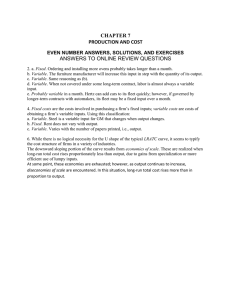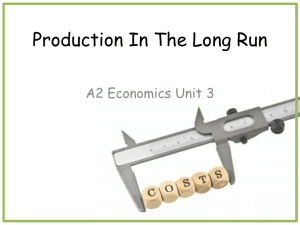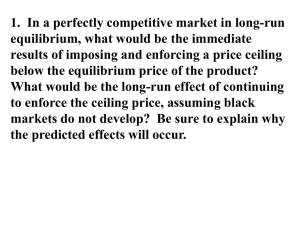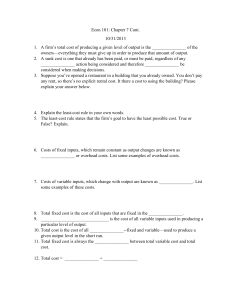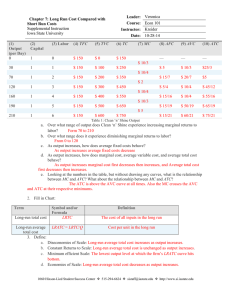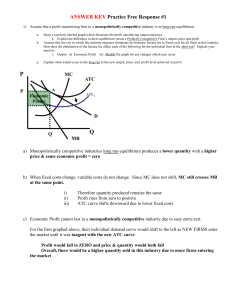Production and Cost Slides by: John & Pamela Hall
advertisement
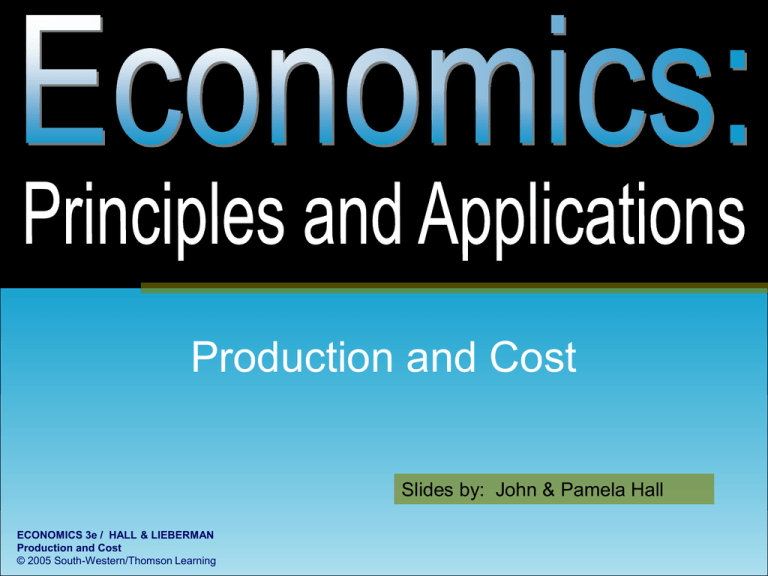
Production and Cost Slides by: John & Pamela Hall ECONOMICS 3e / HALL & LIEBERMAN Production and Cost © 2005 South-Western/Thomson Learning The Nature of the Firm • What is a business firm? – An organization, owned and operated by private individuals, that specializes in production • Production is the process of combining inputs to make outputs • The firm must deal with a variety of individuals and organizations – Sells its output to customers – Receives revenue from them in return • Where does the revenue go? – Much of it goes to input suppliers • The total of all of these payments makes up the firm’s costs of production – When costs are deducted from revenue, what remains is the firm’s profit » Profit = Revenue – Costs 2 The Nature of the Firm • Every firm must deal with the government – Pays taxes to the government – Must obey government laws and regulations – Receive valuable services from the government • Public capital • Legal systems • Financial systems 3 Figure 1: The Firm and Its Environment 4 Types of Business Firms • There are about 24 million business firms in United States—each of them falls into one of three legal categories – A sole proprietorship • A firm owned by a single individual – A partnership • A firm owned and usually operated by several individuals who share in the profits and bear personal responsibility for any losses – Both of the above face • Unlimited liability – Each owner is held personally responsible for the obligations of the firm • The difficulty of raising money to expand the business – Each partner bears full responsibility for the poor judgment of any one of them 5 Types of Business Firms • A corporation – Owned by those who buy shares of stock and whose liability is limited to the amount of their investment in the firm – Ownership is divided among those who buy shares of stock – Each share of stock entitles its owner to a share of the corporation’s profit • Some of this is paid out in dividends • If the corporation needs additional funds it may sell more stock • Offers the stockholder limited liability • However, stockholders suffer double taxation 6 Figure 2: Forms of Business Organization 7 Why Employees? • Most firms have employees – People who work for the firm and receive a wage or salary, but are not themselves owners • Each of us could operate our own oneperson firms as independent contractors – So why don’t more of us do this? • Would not be enjoying the highest standard of living possible to us 8 The Advantages of Employment • Gains from specialization • Lower transaction costs • Reduced risk 9 Further Gains From Specialization • Independent contractor must – – – – Design the good Make the good Deal with customers Advertise services • At a factory each of these tasks would be performed by different individuals who would work full time at their activity 10 Lower Transaction Costs • Transaction costs are time costs and other costs required to carry out market exchanges • In a firm with employees many supplies and services can be produced inside the organization – Firm can enjoy significant savings on transaction costs 11 Reduced Risk • Large firm with employees offers opportunities for everyone involved to reduce risk through – Diversification • Process of reducing risk by spreading sources of income among different alternatives • With large firms, two kinds of diversification are possible – Within the firm – Among firms • These advantages help it attract customers, workers, and potential owners 12 The Limits to the Firm • You might be tempted to conclude that bigger is always better – The larger the firm, the greater will be the cost savings • However, there are limits 13 Thinking About Production • Production naturally brings to mind inputs and outputs • Inputs include resources – – – – – Labor Capital Land Raw materials Other goods and services provided by other firms • Way in which these inputs may be combined to produce output is the firm’s technology 14 Thinking About Production • A firm’s technology is treated as a given – Constraint on its production, which is spelled out by the firm’s production function – For each different combination of inputs, the production function tells us the maximum quantity of output a firm can produce over some period of time 15 Figure 3: The Firm’s Production Function 16 The Short Run and the Long Run • Useful to categorize firms’ decisions into – Long-run decisions—involves a time horizon long enough for a firm to vary all of its inputs – Short-run decisions—involves any time horizon over which at least one of the firm’s inputs cannot be varied • To guide the firm over the next several years – Manager must use the long-run lens • To determine what the firm should do next week – Short run lens is best 17 Production in the Short Run • When firms make short-run decisions, there is nothing they can do about their fixed inputs – Stuck with whatever quantity they have – However, can make choices about their variable inputs • Fixed inputs – An input whose quantity must remain constant, regardless of how much output is produced • Variable input – An input whose usage can change as the level of output changes • Total product – Maximum quantity of output that can be produced from a given combination of inputs 18 Production in the Short Run • Marginal product of labor (MPL) is the change in total product (ΔQ) divided by the change in the number of workers hired (ΔL) ΔQ MPL ΔL – Tells us the rise in output produced when one more worker is hired 19 Figure 4: Total and Marginal Product 20 Marginal Returns To Labor • As more and more workers are hired – MPL first increases – Then decreases • Pattern is believed to be typical at many types of firms 21 Increasing Marginal Returns to Labor • When the marginal product of labor increases as employment rises, we say there are increasing marginal returns to labor – Each time a worker is hired, total output rises by more than it did when the previous worker was hired 22 Diminishing Returns To Labor • When the marginal product of labor is decreasing – There are diminishing marginal returns to labor – Output rises when another worker is added so marginal product is positive – But the rise in output is smaller and smaller with each successive worker • Law of diminishing (marginal) returns states that as we continue to add more of any one input (holding the other inputs constant) – Its marginal product will eventually decline 23 Thinking About Costs • A firm’s total cost of producing a given level of output is the opportunity cost of the owners – Everything they must give up in order to produce that amount of output • This is the core of economists’ thinking about costs 24 The Irrelevance of Sunk Costs • Sunk cost is one that already has been paid, or must be paid, regardless of any future action being considered • Should not be considered when making decisions • Even a future payment can be sunk – If an unavoidable commitment to pay it has already been made 25 Explicit vs. Implicit Costs • Types of costs – Explicit (involving actual payments) • Money actually paid out for the use of inputs – Implicit (no money changes hands) • The cost of inputs for which there is no direct money payment 26 Costs in the Short Run • Fixed costs – Costs of a firm’s fixed inputs • Variable costs – Costs of obtaining the firm’s variable inputs 27 Measuring Short Run Costs: Total Costs • Types of total costs – Total fixed costs • Cost of all inputs that are fixed in the short run – Total variable costs • Cost of all variable inputs used in producing a particular level of output – Total cost • Cost of all inputs—fixed and variable • TC = TFC + TVC 28 Figure 5: The Firm’s Total Cost Curves 29 Average Costs • Average fixed cost (AFC) – Total fixed cost divided by the quantity of output produced AFC TFC Q • Average variable cost (TVC) – Total variable cost divided by the quantity of output produced TVC AVC Q • Average total cost (TC) – Total cost divided by the quantity of output produced TC ATC Q 30 Marginal Cost • Marginal Cost – Increase in total cost from producing one more unit or output • Marginal cost is the change in total cost (ΔTC) divided by the change in output (ΔQ) ΔTC MC ΔQ – Tells us how much cost rises per unit increase in output – Marginal cost for any change in output is equal to shape of total cost curve along that interval of output 31 Figure 6: Average And Marginal Costs 32 Explaining the Shape of the Marginal Cost Curve • When the marginal product of labor (MPL) rises (falls), marginal cost (MC) falls (rises) • Since MPL ordinarily rises and then falls, MC will do the opposite—it will fall and then rise – Thus, the MC curve is U-shaped 33 The Relationship Between Average And Marginal Costs • At low levels of output, the MC curve lies below the AVC and ATC curves – These curves will slope downward • At higher levels of output, the MC curve will rise above the AVC and ATC curves – These curves will slope upward • As output increases; the average curves will first slope downward and then slope upward – Will have a U-shape • MC curve will intersect the minimum points of the AVC and ATC curves 34 Production And Cost in the Long Run • In the long run, costs behave differently – Firm can adjust all of its inputs in any way it wants • In the long run, there are no fixed inputs or fixed costs – All inputs and all costs are variable – Firm must decide what combination of inputs to use in producing any level of output • The firm’s goal is to earn the highest possible profit – To do this, it must follow the least cost rule • To produce any given level of output the firm will choose the input mix with the lowest cost 35 Production And Cost in the Long Run • Long-run total cost – The cost of producing each quantity of output when the least-cost input mix is chosen in the long run • Long-run average total cost – The cost per unit of output in the long run, when all inputs are variable • The long-run average total cost (LRATC) – Cost per unit of output in the long-run LRTC LRATC Q 36 The Relationship Between Long-Run And Short-Run Costs • For some output levels, LRTC is smaller than TC • Long-run total cost of producing a given level of output can be less than or equal to, but never greater than, short-run total cost (LRTC ≤ TC) • Long-run average cost of producing a given level of output can be less than or equal to, but never greater than, short–run average total cost (LRATC ≤ ATC) 37 Average Cost And Plant Size • Plant – Collection of fixed inputs at a firm’s disposal • Can distinguish between the long run and the short run – In the long run, the firm can change the size of its plant – In the short run, it is stuck with its current plant size • ATC curve tells us how average cost behaves in the short run, when the firm uses a plant of a given size • To produce any level of output, it will always choose that ATC curve—among all of the ATC curves available—that enables it to produce at lowest possible average total cost – This insight tells us how we can graph the firm’s LRATC curve 38 Graphing the LRATC Curve • A firm’s LRATC curve combines portions of each ATC curve available to firm in the long run – For each output level, firm will always choose to operate on the ATC curve with the lowest possible cost • In the short run, a firm can only move along its current ATC curve • However, in the long run it can move from one ATC curve to another by varying the size of its plant – Will also be moving along its LRATC curve 39 Figure 7: Long-Run Average Total Cost 40 Economics of Scale • Economics of scale – Long-run average age total cost decreases as output increases • When an increase in output causes LRATC to decrease, we say that the firm is enjoying economics of scale – The more output produced, the lower the cost per unit • When long-run total cost rises proportionately less than output, production is characterized by economies of scale – LRATC curve slopes downward 41 Figure 8: The Shape Of LRATC 42 Gains From Specialization • One reason for economies of scale is gains from specialization • The greatest opportunities for increased specialization occur when a firm is producing at a relatively low level of output – With a relatively small plant and small workforce • Thus, economies of scale are more likely to occur at lower levels of output 43 More Efficient Use of Lumpy Inputs • Another explanation for economies of scale involves the “lumpy” nature of many types of plant and equipment – Some types of inputs cannot be increased in tiny increments, but rather must be increased in large jumps • Plant and equipment must be purchased in large lumps – Low cost per unit is achieved only at high levels of output • Making more efficient use of lumpy inputs will have more impact on LRATC at low levels of output – When these inputs make up a greater proportion of the firm’s total costs • At high levels of output, the impact is smaller 44 Diseconomies of Scale • Long-run average total cost increases as output increases • As output continues to increase, most firms will reach a point where bigness begins to cause problems – True even in the long run, when the firm is free to increase its plant size as well as its workforce • When long-run total cost rises more than in proportion to output, there are diseconomies of scale – LRATC curve slopes upward • While economies of scale are more likely at low levels of output – Diseconomies of scale are more likely at higher output levels 45 Constant Returns To Scale • Long-run average total cost is unchanged as output increases • When both output and long-run total cost rise by the same proportion, production is characterized by constant returns to scale – LRATC curve is flat • In sum, when we look at the behavior of LRATC, we often expect a pattern like the following – Economies of scale (decreasing LRATC) at relatively low levels of output – Constant returns to scale (constant LRATC) at some intermediate levels of output – Diseconomies of scale (increasing LRATC) at relatively high levels of output • This is why LRATC curves are typically U-shaped 46 Using the Theory: Long Run Costs, Market Structure and Mergers • The number of firms in a market is an important aspect of market structure—a general term for the environment in which trading takes place • What accounts for these differences in the number of sellers in the market? – Shape of the LRATC curve plays an important role in the answer 47 LRATC and the Size of Firms • The output level at which the LRATC first hits bottom is known as the minimum efficient scale (MES) for the firm – Lowest level of output at which it can achieve minimum cost per unit • Can also determine the maximum possible total quantity demanded by using market demand curve • Applying these two curves—the LRATC for the typical firm, and the demand curve for the entire market—to market structure – When the MES is small relative to the maximum potential market • Firms that are relatively small will have a cost advantage over relatively large firms • Market should be populated by many small firms, each producing for only a tiny share of the market 48 LRATC and the Size of Firms • There are significant economies of scale that continue as output increases – Even to the point where a typical firm is supplying the maximum possible quantity demanded • This market will gravitate naturally toward monopoly • In some cases the MES occurs at 25% of the maximum potential market – In this type of market, expect to see a few large competitors • There are significant lumpy inputs that create economies of scale – Until each firm has expanded to produce for a large share of the market 49 Figure 9: How LRATC Helps Explain Market Structure 50 Figure 9: How LRATC Helps Explain Market Structure 51 Figure 9: How LRATC Helps Explain Market Structure 52 Figure 9: How LRATC Helps Explain Market Structure 53 LRATC and the Size of Firms • The MES of the typical firm in this market is 1,000 units – Lowest output level at which it reaches minimum cost per unit – For firms in this market, diseconomies of scale don’t set in until output exceeds 10,000 units • Since both small and large firms can have equally low average costs with neither having any advantage over the other – Firms of varying sizes can coexist 54 The Urge To Merge • If by doubling their output, firms could slide down the LRATC curve in Figure 9, and enjoy a significant cost advantage over any other, stillsmaller firm, they would – This is a market that is ripe for a merger wave • A sudden merger wave is usually set off by some change in the market • Market structure in general—and mergers and acquisitions in particular—raise many important issues for public policy – Low-cost production can benefit consumers—if it results in lower prices 55
